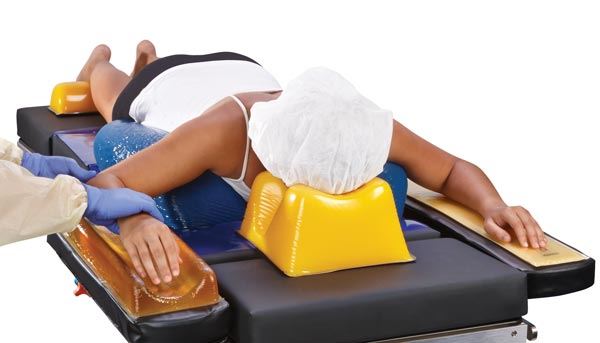
The goal of the surgical position is to provide optimal visualization of, and access to, the surgical site that causes the least physiological compromise of the patient, while also protecting the skin and joints.
- Association of Surgical Technologists
Safe Patient Positioning Reduces O.R. Injuries
Each year an estimated 1.3 to 3 million adults get hospital-acquired pressure ulcers, and 23% to 66% of ulcers occur in the operating room. Surgical patients are more susceptible to developing pressure-related injuries due to prolonged periods of patient immobility, poor positioning, compromised circulatory function under anesthesia, and preexisting conditions such as diabetes and obesity. Nursing care costs and time can increase by 50% for each pressure ulcer acquired during a surgical procedure, and stage 3 or 4 pressure ulcers that occur after hospital admission are “never events” that will not be reimbursed.
AliMed and our clinician partners apply extensive research and design to developing specific solutions to meet the surgical patients’ needs. AliMed manufactures its positioners using premium materials with proven efficacy, such as silicone and elastomer gels that mimic fatty tissue, expand pressure distribution, and reduce injury risk.
To assist with infection prevention, AliMed offers disposable foam positioners in kits for easy storage, and to reduce cross-contamination risks. Additionally, AliMed offers a wide array of reusable foam positioners, including positioners with antimicrobial Protecta-Coat™ coating impregnated with ionic silver particles and impervious to fluids.
To meet the needs of customers seeking reusable gel for its durability and efficacy during long procedures, AliMed carries AliGel™, AliLite™, and Azure. All leverage viscoelastic polymers, material recommended by AORN to reduce the incidence of pressure ulcers.
AliBlue, AliMed's economical cost-effective gel positioner, features the same premium pressure management relief properties as other gel positioners. AliBlue is made of 100% polyurethane-based viscoelastic gel that is easy to clean and impervious to fluids. AliBlue positioners are designed for a variety of positions and procedures.
AliGel — the gold standard in positioning — contains an outer surface that is softer than skin. The underlying gel moves with the patient to reduce shear and evenly distribute pressure. Additionally, AliGel retains its shape better than less dense gel positioners. With more than one hundred shapes and sizes, you’ll find a positioner for clinical needs.
AliLite, AliMed’s lightest gel positioner, features a durable combination of naturally antimicrobial silicone gel and lightweight foam with an anti-slip base for stability. Anatomical precontouring facilitates greater conformity between gel and the body’s shape as weight is redistributed over a larger area, reducing the risk of pressure points. More than 50% lighter than comparable gel-only products, AliLite positioners are designed for easier handling by medical staff during patient positioning.
Azure, AliMed’s premium offering, consists of two independent silicone gel layers that work in combination to allow the positioners to effectively conform to the patient’s shape in a more contoured manner, with less settling. Azure positioners are ideal for use during long O.R. procedures.
Reduce the incidence of O.R.-acquired pressure sores by using the most effective pressure relief available. AliMed’s positioning products protect bony prominences and minimize nerve pressure while promoting circulation and respiratory function. Use these products to attain secure access to the surgical site with the least physiological compromise of the patient.
Sources:
- The Association of Surgical Technologists Recommended Standard Practices for Surgical Positioning. AST. 2011 April; 1:1
- Lorenz JM. Geriatric skin care. VA healthcare system nurses assess, treat, and prevent pressure ulcers using a systematic, interdisciplinary approach. Adv Nurse. 2007; 9(11): 39
- Shoemake BA, Susan, Stoessel RN BSN MS, Kathleen. Pressure Ulcers in the Surgical Patient. Clin Iss. Kimberly-Clark Knowledge Network. 2007; 1.
- Sanders W, Allen RD. Pressure Management in the Operating Room: Problems and Solutions. Managing Infection Control 2006; 6(9):63-72.
- Maklebust J. Pressure Ulcers: Etiology and Prevention. Nurs Clin North Am.1987 Jun; 22(2):359-77.
- Hoshowsky, V. M., and Schramm, C. A. “Intra operative Pressure Sore Prevention: An Analysis of Bedding Materials.” Research in Nursing & Health 17, (1994): 333-339.
- Armstrong RN, Diana, Bortz RN, Pamela. An Integrative Review of Pressure Relief in Surgical Positioning. AST. 2011 April; 1:1